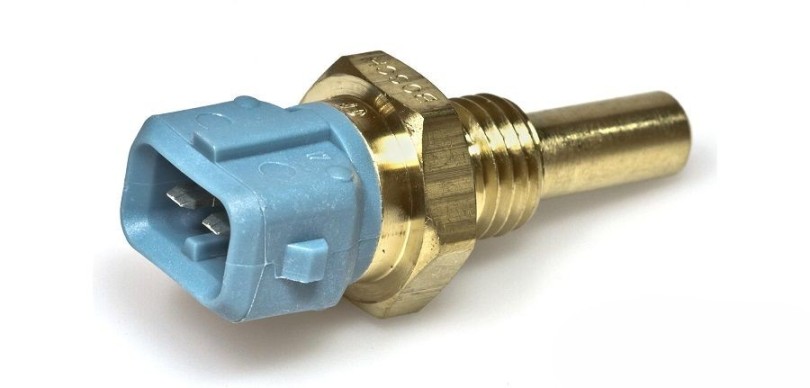Coolant temperature sensor (CTS) is a pivotal component in a vehicle’s engine management system that monitors the engine coolant temperature. This sensor provides crucial data to the engine control unit (ECU), which adjusts several key functions such

as fuel injection, ignition timing, and cooling system operation. By delivering real-time information, the coolant temperature sensor helps the engine run efficiently and prevents overheating, making it essential for overall vehicle health.
The CTS’s ability to maintain optimal engine temperature significantly impacts performance, fuel economy, and emissions control. Its role extends beyond just temperature monitoring, as it directly influences the ECU’s decisions, ensuring the engine performs at its best under various driving conditions.
Working Mechanism of a Coolant Temperature Sensor
How It Functions
The coolant temperature sensor typically uses a thermistor—a resistor that changes its resistance with temperature fluctuations. Most automotive sensors are NTC (Negative Temperature Coefficient) thermistors, meaning their resistance decreases as the temperature rises. When the coolant is cold, the resistance is high, sending a higher voltage signal to the ECU. As the engine warms up, the resistance drops, and the voltage decreases, allowing the ECU to adjust the air-fuel ratio and ignition timing to maintain optimal engine operation.
Placement in Different Vehicles
The sensor is usually located near the thermostat housing, cylinder head, or engine block, positioned to directly measure the coolant temperature as it circulates through the engine. While its location can vary by vehicle make and model, it is always strategically placed to provide the most accurate temperature readings to the ECU.
Different Types of Coolant Temperature Sensors
NTC Thermistors
NTC thermistors are the most commonly used sensors in vehicles today. They provide reliable, accurate measurements of coolant temperatures, enabling precise adjustments by the engine management system. Their simple design makes them both cost-effective and dependable.
Analog vs. Digital Sensors
- Analog Sensors: These sensors provide a continuous signal that varies proportionally with temperature changes. They are traditional and found in older vehicles but still function effectively in many modern applications.
- Digital Sensors: More advanced than their analog counterparts, digital sensors send discrete binary signals to the ECU, making them more accurate and responsive. These are preferred in modern vehicles that require faster and more precise data processing.
Vehicle-Specific Sensors
Some sensors are designed with specific applications in mind, catering to performance engines or specialized cooling requirements. These sensors are built to withstand extreme conditions and offer enhanced durability and precision.
The Critical Role of Coolant Temperature Sensors in Vehicles
Controlling Engine Temperature
The primary function of the coolant temperature sensor is to help regulate the engine’s operating temperature. By providing continuous feedback to the ECU, the sensor allows the system to make real-time adjustments, such as activating cooling fans or modifying the air-fuel mixture, preventing the engine from overheating.
Enhancing Fuel Economy
Accurate temperature readings enable the ECU to adjust the fuel mixture precisely, promoting efficient combustion. A properly functioning sensor helps maintain the ideal air-fuel ratio, which improves fuel efficiency and reduces harmful emissions.
Maintaining Optimal Engine Operation
By keeping the engine temperature within the desired range, the sensor helps the vehicle achieve peak performance. This ensures smooth acceleration, stable idling, and overall better driving dynamics, which are crucial for both daily commutes and long-distance travel.
Symptoms of a Malfunctioning Coolant Temperature Sensor
Warning Lights
One of the earliest signs of a failing coolant temperature sensor is the activation of the check engine light on your dashboard.

This warning is often triggered when the ECU receives erroneous or no data from the sensor.
Increased Fuel Usage
A faulty sensor can cause the ECU to miscalculate the fuel mixture, often leading to a richer mixture than necessary. This results in increased fuel consumption and a noticeable drop in fuel efficiency.
Overheating Risks
A malfunctioning sensor may not accurately report rising temperatures, leading the ECU to fail in adjusting the cooling system. This can cause the engine to overheat, risking severe damage to engine components.
Poor Engine Performance
Inaccurate temperature readings can disrupt the engine’s timing and fuel delivery, leading to rough idling, stalling, and difficulty starting the vehicle. These performance issues often point to a faulty sensor that needs immediate attention.
Common Causes of Coolant Temperature Sensor Failure
Electrical Problems
Issues such as short circuits, broken wires, or poor connections can cause the sensor to fail. Electrical faults are common and can lead to intermittent sensor operation or complete failure.
Contamination and Corrosion
Exposure to contaminants like oil, dirt, and old coolant can corrode the sensor over time, degrading its performance. Regular coolant changes and keeping the engine bay clean can help prevent this issue.
Physical Damage and Wear
Physical impacts, whether from engine vibrations, accidental hits during repairs, or improper handling, can damage the sensor. Over time, normal wear and tear can also affect the sensor‘s accuracy and functionality.
How to Diagnose a Faulty Coolant Temperature Sensor
Utilizing OBD-II Scanners
An OBD-II scanner can be used to check for error codes related to the coolant temperature sensor. Codes such as P0115 or P0117 often indicate sensor issues that need further inspection.
Multimeter Resistance Tests
Testing the sensor’s resistance at various temperatures using a multimeter can confirm its condition. The sensor’s resistance should match the manufacturer’s specifications for given temperature ranges.
Voltage Readings Evaluation
Testing voltage outputs while the engine runs can reveal abnormal readings that indicate a faulty sensor. Consistent voltage anomalies often suggest the need for a replacement.
Steps to Replace a Coolant Temperature Sensor
Required Tools
- Multimeter
- OBD-II scanner
- Wrenches or socket set
- Replacement sensor
- Coolant catch pan
- Safety gloves and goggles
Detailed Replacement Guide
- Locate the Sensor: Identify where the sensor is positioned in your engine bay.
- Disconnect the Battery: Always start by disconnecting the battery to prevent any electrical hazards.
- Drain the Coolant: If necessary, partially drain the coolant to access the sensor without spillage.
- Remove the Old Sensor: Use the correct tools to carefully unscrew and remove the faulty sensor.
- Install the New Sensor: Insert the new sensor into place and secure it tightly.
- Refill the Coolant: Refill any lost coolant and check for leaks around the sensor.
- Reconnect the Battery and Test: Reconnect the battery, start the engine, and verify that the new sensor is functioning correctly.
Safety Measures
- Always work on a cooled engine to avoid burns from hot components.
- Use protective gear to handle coolant, which can be harmful upon contact.
Replacement Costs of Coolant Temperature Sensors
Cost Factors
The cost of replacing a coolant temperature sensor varies based on the vehicle, the quality of the replacement part, and labor rates. Prices for parts generally range from $20 to $100, while professional labor can add another $50 to $150.
DIY vs. Mechanic Service
- DIY Replacement: Offers significant cost savings if you have the right tools and mechanical knowledge.
- Mechanic Service: Provides professional assurance and often includes a warranty on the work, albeit at a higher overall cost.
Preventative Measures and Maintenance Tips
Routine Inspections
Regularly inspect the sensor and its electrical connections during routine maintenance checks. Early detection of issues can

prevent more serious sensor failures.
Maintaining Coolant Quality
Keeping your vehicle’s coolant clean and at the correct level is essential for sensor health. Regularly replace old coolant to avoid contamination that can lead to sensor corrosion.
Frequently Asked Questions (FAQs)
What occurs if the sensor malfunctions?
A faulty sensor can cause poor engine performance, overheating, and increased fuel consumption due to incorrect data being sent to the ECU.
Is it safe to drive without a coolant temperature sensor?
Driving without a functional sensor is not recommended, as it can lead to engine overheating and other performance issues.
What is the typical lifespan of these sensors?
Coolant temperature sensors usually last between 50,000 to 100,000 miles, but lifespan varies based on driving conditions and maintenance habits.
How can I prolong my sensor’s life?
Regular maintenance, ensuring proper coolant levels, and inspecting sensor connections can help extend its operational life.
What temperature range does the sensor monitor?
The sensor monitors temperatures from approximately -40°F to 260°F (-40°C to 125°C), covering the full operating range of the engine.
How often should sensors be checked or replaced?
Sensors should be checked during routine maintenance or if any signs of failure appear. Replacement is typically only necessary when symptoms arise.
Conclusion
The coolant temperature sensor is a vital component that ensures your engine operates efficiently, remains fuel-efficient, and stays within safe temperature limits. Regular checks and timely replacements can prevent severe engine damage, improve performance, and enhance fuel economy. Staying proactive with maintenance helps you get the most out of your vehicle and avoid costly repairs.


